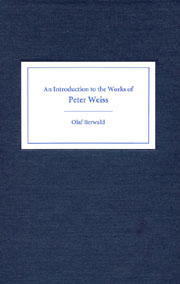Book contents
- Frontmatter
- Contents
- Acknowledgments
- Introduction
- 1 Subversive Slapstick: The Early Plays Der Turm, Die Versicherung, Nacht mit Gästen, and Mockinpott
- 2 The Choreography of Documents: Die Ermittlung, Gesang vom Lusitanischen Popanz, and Viet Nam Diskurs
- 3 Staging Writers as Outcasts: Marat/Sade, Trotzki im Exil, Hölderlin, Der Prozess, and Der neue Prozess
- 4 Scenarios of Stagnation: Early Prose
- 5 Autobiography and Fiction: Abschied von den Eltern, Fluchtpunkt, and Rekonvaleszenz
- 6 Poetics and Politics: Essays, Open Letters, and Fragments
- 7 Perception as Resistance: Die Ästhetik des Widerstands
- Works Consulted
- Index
7 - Perception as Resistance: Die Ästhetik des Widerstands
Published online by Cambridge University Press: 05 February 2013
- Frontmatter
- Contents
- Acknowledgments
- Introduction
- 1 Subversive Slapstick: The Early Plays Der Turm, Die Versicherung, Nacht mit Gästen, and Mockinpott
- 2 The Choreography of Documents: Die Ermittlung, Gesang vom Lusitanischen Popanz, and Viet Nam Diskurs
- 3 Staging Writers as Outcasts: Marat/Sade, Trotzki im Exil, Hölderlin, Der Prozess, and Der neue Prozess
- 4 Scenarios of Stagnation: Early Prose
- 5 Autobiography and Fiction: Abschied von den Eltern, Fluchtpunkt, and Rekonvaleszenz
- 6 Poetics and Politics: Essays, Open Letters, and Fragments
- 7 Perception as Resistance: Die Ästhetik des Widerstands
- Works Consulted
- Index
Summary
Weiss's main contribution to world literature, the three-volume novel Die Ästhetik des Widerstands (The Aesthetics of Resistance), which was published between 1975 and 1981, resists clear genre classification. The narrative's prosaic descriptions of artwork change into disturbingly dense and evocative poetic representations of corporeal pain and endangerment. The historically based novel documents the lives and deaths of German resistance fighters against the Nazi regime. Despite its documentary character, the text remains a work of fiction, operating with an abundance of intertextual allusions and mythological undercurrents. The protagonists patiently expose themselves to the works of Dante, Kafka, Géricault, and many others. In letters and vivid discussions that they consider to be an integral part of their fight against the Nazi regime, they constantly revise their understanding of specific works of art. Weiss's novel stands in a rich literary tradition. Not only does it explicitly thematize Dante's and Kafka's works, but it also continues the project of blending philosophy and literature that the modernist novelists James Joyce, Marcel Proust, and Robert Musil had so brilliantly explored.
Die Ästhetik des Widerstands, whose characters are all based on real people, forces the reader to think through the complex connections between memory, art, and survival. The text celebrates the courage and mourns the executions of members of the resistance group “Rote Kapelle” (Red Orchestra, or Red Chapel) that fought against the Hitler regime. Told by a nameless first person narrator who joins the resistance group, the novel operates with sudden temporal and geographic shifts and cuts.
- Type
- Chapter
- Information
- An Introduction to the Works of Peter Weiss , pp. 107 - 130Publisher: Boydell & BrewerPrint publication year: 2003

